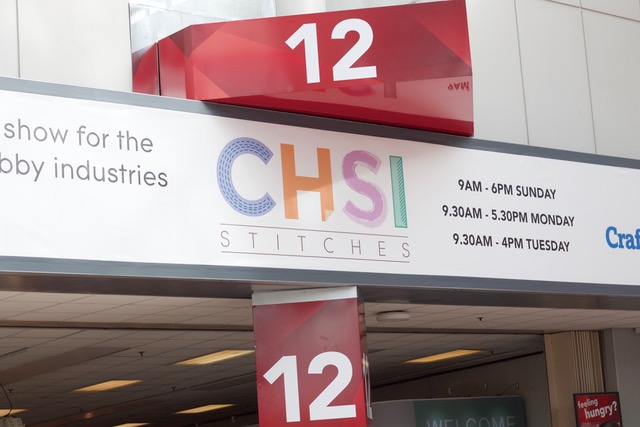
I first attended CHSI Stitches in 2015 as a speaker in their Business Seminar sessions. Stitches, billed by the organizers as “Europe’s No.1 Creative Craft Trade Show for the art, craft, fabric, needlecraft and hobby industries” is held every February at the NEC just outside of Birmingham, UK. According to the press bumph, they have more than 250 exhibitors. For those of you not familiar with the NEC, it is the UK’s largest exhibition venue, hosting everything from industry conferences to music concerts. My aim on this visit was to speak to those within the industry about Stitches, while also making sure to have time to walk the floor so as to be able to give my impressions as an observer.

The floor is a mix of exhibitors from across the most popular crafting mediums with both large companies (Fiskars, Prym, and Korbond are well-known names) alongside small and upcoming exhibitors, some who attend as part of the Bright Sparks, New Designers initiative. The Bright Sparks Initiative allows a limited number of small companies to have, among other things, an exhibition space for two years at a reduced rate. After the second year, they have to revert to paying full price, no matter what size their company is. Jules Fallon, the owner of Sew Me Something, a shop teaching dressmaking courses as well as producing a growing line of independent sewing patterns, has attended the last two years as part of this initiative. Her main aim is to promote her patterns to a wider audience, and I asked her if she felt that it was a good investment coming to Stitches “Yes, it is a good opportunity for us to meet the public as well as potential distributors. As this show is local to us, (we’re based in Stratford upon Avon), we don’t have to worry about accommodation. So the main cost for us is the cost of the stand, and the lights and electrics the are charged on top… although it was touch and go as to whether we would actually be there this year, prices are just rocketing!”
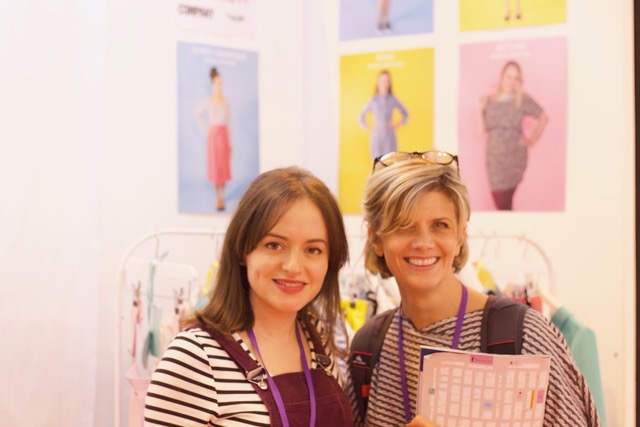
One of the most well-known sewing personalities Tilly Walnes, from the first group of contestants from Series One of the Great British Sewing Bee, was at Stitches for the second year in a row. Tilly now runs her award-winning blog Tilly and The Buttons, which inspires sewers with her unique style of sewing patterns. I asked Tilly about her experience as an exhibitor at Stitches, “This will be our second year exhibiting at Stitches. Our first year was great as it allowed us to get in front of new wholesale customers and put our sewing patterns in their hands so they could see and feel the quality themselves. We made back most of the cost of exhibiting from direct sales at the show, and much more from repeat orders from new customers who we met there.”
“The show also allowed us to meet many of our existing stockists face-to-face and firm up those relationships. We mainly communicate with them by email, so it’s important to put names to faces, get to know them better and hear their feedback firsthand.”
“A third reason for us to exhibit is to show the industry that we’re here, we’re established, and we can afford to exhibit at a trade show. Big businesses don’t always take small craft companies seriously. As a woman leading a small yet growing business, it’s important for me to make it clear that we’re professional, profitable and ambitious. Just being seen with a stand can make people take you more seriously as a business.”
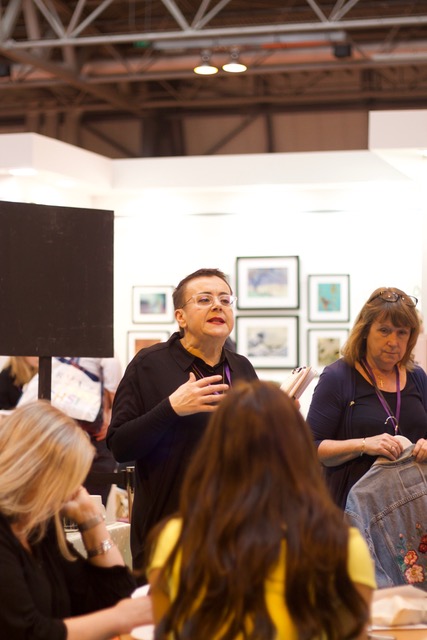
There were notable absences to the usual exhibitors, namely Coats, the long-time British stalwart for wool and fabric, which no longer has a UK based office. Wool and embroidery were still very much represented on the floor and from the looks of what I could see, embroidery is set to be the new big trend on the high street. The lovely people at DMC gave both myself and my daughter a lesson on using their Soluble Canvas which was preprinted with letters, making it easier to create a simple embroidered look. I would describe it as a dummies guide to embroidery, but I can see where that will help people who want to learn but don’t have the time to make it super precise.

While on a much-needed break in the lobby, I bumped into small wool shop owner Lucy Tones. In September of 2016, Lucy bucked the trend and opened a wool shop called Magnolia Tree Crafts on her local Cheshire village. This was Lucy’s first visit to Stitches as she was interested in meeting up with potential new suppliers. I asked Lucy what her impression was about the event, as a first time attendee, “I am looking forward to seeing all the different suppliers under one roof and seeing at what else there is out there to inspire me as a shop owner. I am booked onto a few of the talks at the Business Seminar session and am interested in seeing what they have to say”. Lucy is what I would describe as a digitally savvy shop owner in that she uses social media effectively to grow her business. We agreed to grab a cup of coffee later on in the day so she could give me feedback on what the Business Seminar event was like for her as the talks that she had booked on were about blogging and effective use of social media.
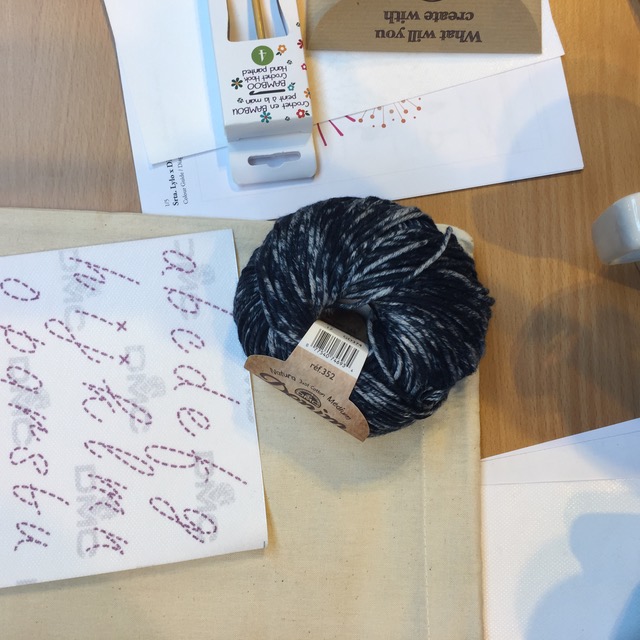
In speaking with several other shop owners on the floor (we makers are a pretty sharing bunch when stood at a stand looking at craft supplies!), the general sentiment is that owning a shop is still hard work and not getting any easier. The cost of renting a shop, while competing with on-line shops, continues to bear down on shop owners. But having an online business isn’t always a threatening force for craft businesses as it can be put to good use as is the case in the Blog of the Year, The Fold Line, which received their award on the Sunday night as part of The British Craft Awards. Started 18 months ago by Kate and Rachel, the Fold Line is an on-line community created to share sewing information as well as an extensive pattern database. Fresh from the awards ceremony, I asked Kate what her feeling was about the state of the sewing industry after having spent time at Stitches, “This is our first year attending CHSI Stitches as our company started 18 months ago. CHSI Stitches is a great opportunity to meet the owners of businesses we already work with in person. As an online company, most of our communication with sewing businesses is via email but it’s nice to have an event where everyone comes together and we can talk face to face”.
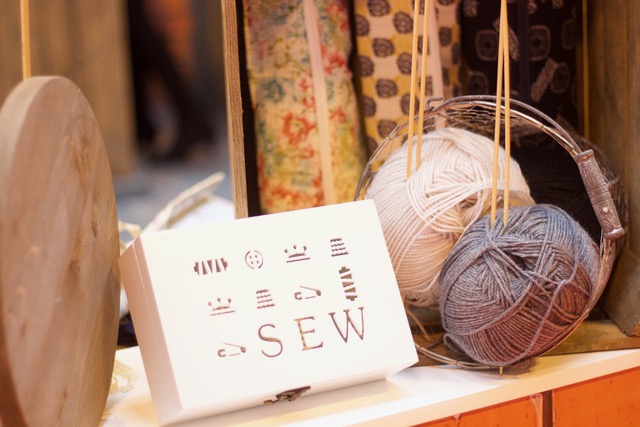
“Our impression of the sewing industry is that it continues to grow, both with new businesses starting and people choosing to learn how to sew as a hobby. We’ve also seen a big increase in the number of creative makers turning their love of sewing into a small business, particularly designing PDF sewing patterns. There is now quite a bit of competition for sewing businesses with makers looking for more variety in dressmaking fabrics in particular. Although it is difficult for new fabric and haberdashery businesses to compete with established brands, social media is providing a platform to reach new customers more quickly.” She also pointed out that the cancellation of the Great British Sewing Bee was a shame as it had made a genuine difference in raising the profile of the industry and would be missed be retailers.
I made my way out to meet Lucy as time was ticking by – I was interested in her thoughts on the business seminars she was planning on attending. There was a wide variety – How to Build Your Brand to a more broadly appealing How to Make a Great First Impression – which were running throughout the three-day event. Her immediate reaction was mixed. “The one I was really looking forward to attending was on successful social media as I know how important that is for my shop. Did I learn anything I didn’t already know? Not really. It was a very general view on social media where we were urged to sign up for the speaker’s on-line course.” I asked her if she thought her experience was partially due to the fact she already had a good knowledge of how social media could work for her business and she disagreed. “I am part of a few Facebook groups of craft business owners and the posts on their forums were that it was pretty much ‘same old, same old’ and I have to agree.” In looking at the list of speakers for topics in the Business Seminar series, there was repetition from the previous year and in some cases, this was the third year that some of the speakers were presenting on the same subject. And of the total number of speakers, over half were men, which is a bit at odds with the fact that the industry is primarily powered by women.

There is no doubting the networking potential that Stitches offers. My daughter, who had come with me, pointed out that I seemed to know everyone as I kept having to stop to say hello. I can assure you that wasn’t the case but there is a high concentration of people in the craft industry all under one roof so you can touch base with old contacts and make new ones very easily. If you really used your time wisely, I am sure you could make some very valuable contacts.
What would be the things that I think Stitches needs to work on? They are in a position of being the industry event that everyone attends partly because there really isn’t one available to compete. If they want to stay relevant in an increasingly digital age, they will need to have a social media strategy that is part of their overall marketing strategy to ensure they reach the younger, more digital savvy users. Their business seminars need to find women in the industry that can speak on the topics that are of interest and reinforce that women can succeed in business. And possibly create a tiered system so that small businesses who aren’t part of the Bright Sparks campaign are able attend but not have to pay full price.

Maeri Howard
contributor

Stitches can’t actually lay claim to being the biggest crafts trade fair in Europe anymore, at least not based on the exhibitor number in this article. Creativeworld, in Frankfurt, had 344 exhibitors this year according to their official post-show press release.